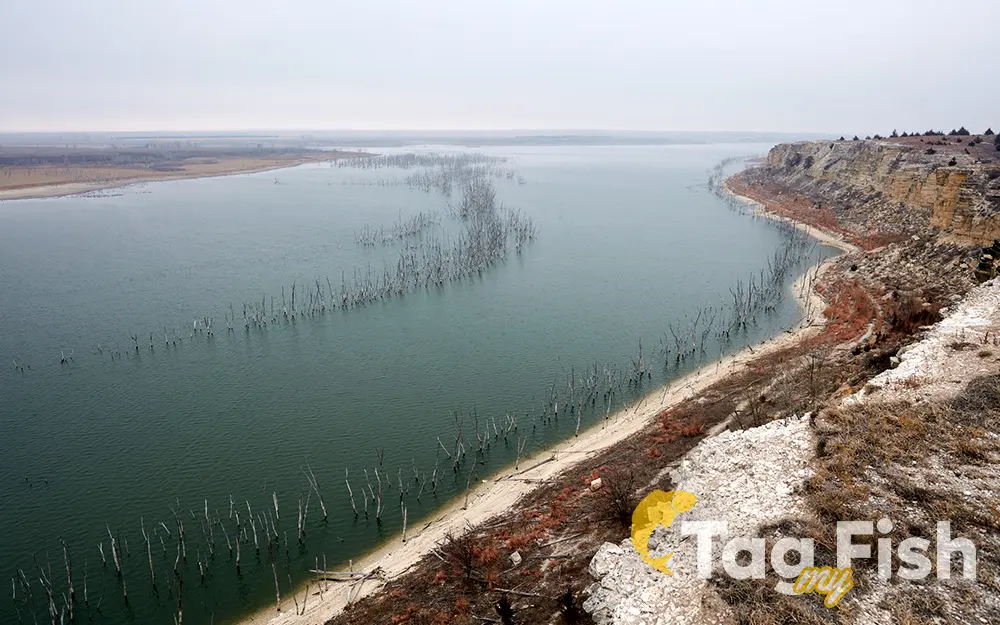Cedar Bluff Reservoir

General data
- Name: Cedar Bluff Reservoir
- Basin: Missouri River
- Water type: Artificial lake
- Progression: Smoky Hill River -> Kansas River -> Missouri River -> Mississippi River -> Gulf of Mexico -> Atlantic Ocean -> Planet Earth
- Climates: Subtropical
- Continents: North America
- Countries: United States of America
Description
Cedar Bluff Reservoir is a reservoir in Trego County, Kansas, United States. Built and managed by the U.S. Bureau of Reclamation for irrigation and area water supply, it is also used for flood control and recreation. Cedar Bluff State Park is located on its shore. The severe drought in western Kansas during the 1930s created demand for irrigation projects and new sources for municipal water supplies. In response, the U.S. Bureau of Reclamation began investigating the Smoky Hill River basin in 1941 to determine what would be feasible, but the outbreak of World War II halted the effort. The Flood Control Act of 1944 authorized the creation of Cedar Bluff Reservoir as part of the Pick-Sloan Missouri Basin Program, and investigations resumed in 1945. Construction of the reservoir and Cedar Bluff Dam began April 1, 1949 and took over two years to complete, finishing September 29, 1951. Difficulties in organizing an irrigation district delayed construction of a water distribution system for several years. Finally, in 1958, the Cedar Bluff Irrigation District was organized. Construction of the 18-mile (29 km) Cedar Bluff Canal commenced in February 1961 and finished in July 1963. In April 1963, the city of Russell, Kansas signed a contract with the Bureau of Reclamation to use a portion of Cedar Bluff Reservoir as a municipal and industrial water supply. In 1959, the Bureau of Sport Fisheries and Wildlife established the Cedar Bluff National Fish Hatchery immediately east of the dam. Receiving its water from the reservoir, the hatchery raised fish stocks to supply waters in western Kansas, eastern Colorado, Oklahoma, and Texas. The flow of the Smoky Hill River declined sharply starting in the late 1960s, likely due to an increase in ground water pumping and the high evaporation rate in the region. The use of the reservoir for irrigation ended in 1978, and the Canal was shut down. The fish hatchery closed in 1983 and was re-purposed to raise Canada geese. The Cedar Bluff Irrigation District dissolved in 1994, and control of the portion of reservoir capacity dedicated to irrigation transferred to the Kansas Water Office and the Kansas Department of Wildlife and Parks. Since the end of irrigation operations, the primary uses of Cedar Bluff Reservoir have been for recreation, overseen by the Kansas Department of Wildlife and Parks, and for flood control and municipal water supply, managed by the Bureau of Reclamation. Cedar Bluff Reservoir is open for sport fishing year-round. Hunting is permitted on the public land around the reservoir although it is restricted in certain areas. West of the park is Threshing Machine Canyon, the site of an 1867 American Indian attack on a wagon train carrying a threshing machine. The canyon walls still bear carvings dating back to the mid-1800s. Fish species resident in Cedar Bluff Reservoir include black bass, bluegill, catfish, crappie, walleye, white bass, and wiper. Game animals living around the reservoir include mule deer, porcupines, pheasants, turkeys, and whitetail deer. Doves, ducks, and geese migrate through the area seasonally. Bald eagles and golden eagles visit in winter. An established zebra mussel population has been documented at this water making Cedar Bluff an ANS designated water. With this designation, regulations are in effect primarily aimed at discouraging water containing microscopic zebra mussel larvae from leaving the property and establishing in new waters.


